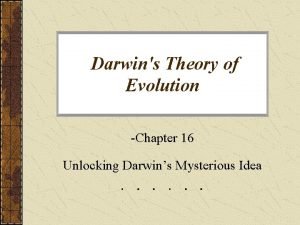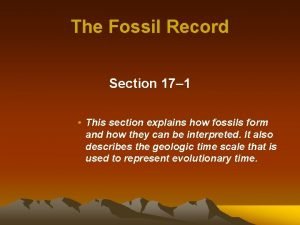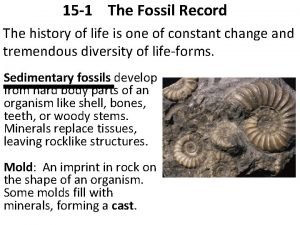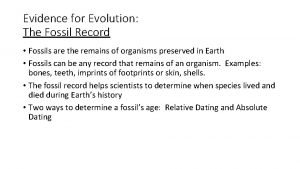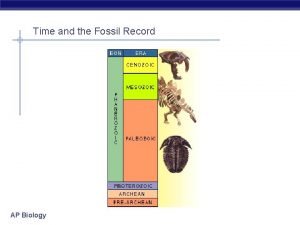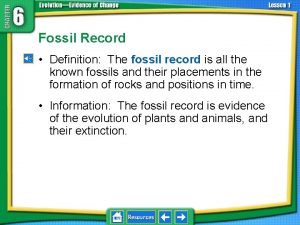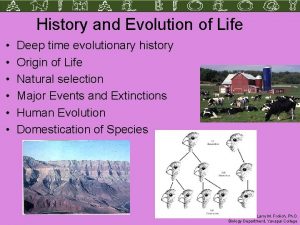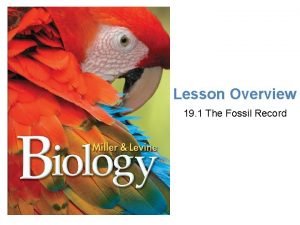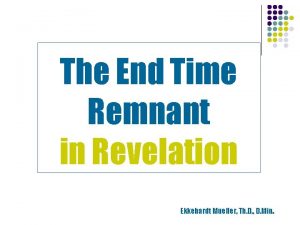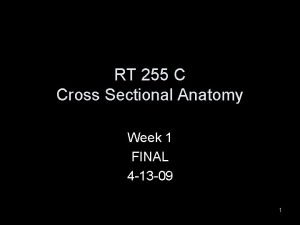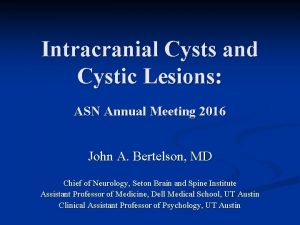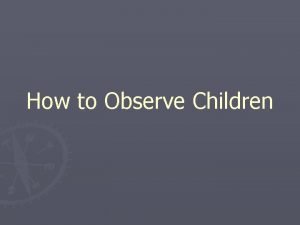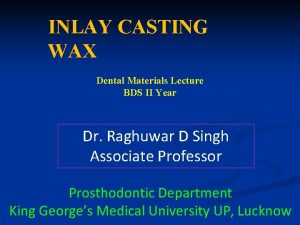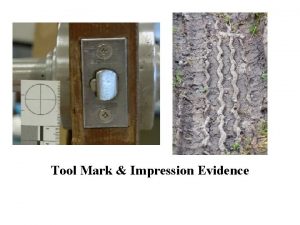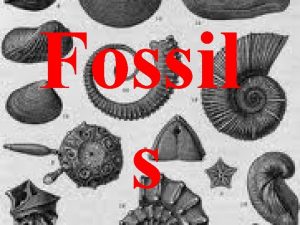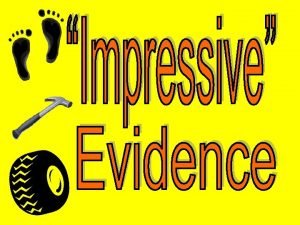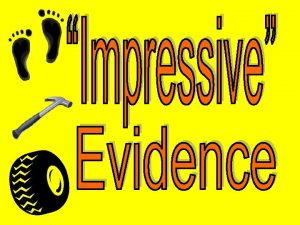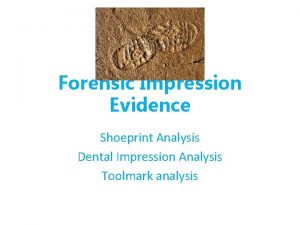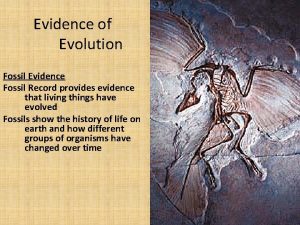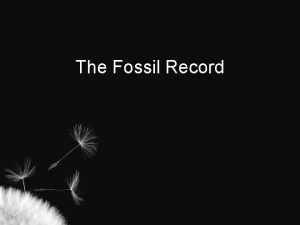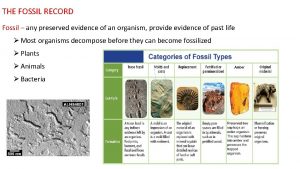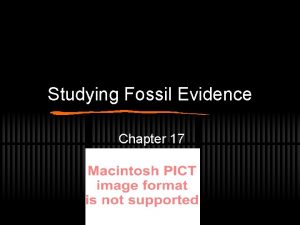The Fossil Record FOSSIL is a remnant impression

























![Harvard University paleontologist Stephen Jay Gould… morphological [anatomical or structural] change is usually limited Harvard University paleontologist Stephen Jay Gould… morphological [anatomical or structural] change is usually limited](https://slidetodoc.com/presentation_image_h/c49d189aa383b34e053fb49f09033588/image-26.jpg)












![Fossil record well represented… “when estimates are made of the percentage of [now-] living Fossil record well represented… “when estimates are made of the percentage of [now-] living](https://slidetodoc.com/presentation_image_h/c49d189aa383b34e053fb49f09033588/image-39.jpg)



























- Slides: 66

The Fossil Record

“FOSSIL is a remnant, impression, or trace of an animal or plant that has been preserved in the earth. Usually, a fossil is simply the skeleton (or impression of the skeleton) of a dead creature preserved or molded in hardened rock found Modern Biology, Temple Press, 1998 in sedimentary layers. ”

“Sedimentary rocks are formed from overburden pressure as particles of sediment are deposited out of air, ice, or water flows carrying the particles in suspension. ” http: //www. graniteland. com/stone/info/sedimentary-rock. php

Sedimentary rock is where the fossils are found! Sedimentary rocks can contain fossils because, unlike most igneous and metamorphic rocks, they form at temperatures and pressures that do not

Examples of Dating Rocks that were created since the 1980 eruption of Mount St. Helens dated up to 2. 8 million years old

Mount St. Helens on May 17, 1980, one day before the devastating eruption.

steam plume on May 19, 1982

Common false notions. . Fossils = evolution Many fossils = evolution is fact! Big pile of fossils w/o transitional fossils = big pile of bones!

The Fossil Record and Education Biology: Principles and Explorations, Holt, Rinehart, Winston, 2001, p. 283. Shoul “Fossilsdoffer the most direct evidence that evolution takes place…. Fossils, therefore, provide an actual record of Earth’s past Dolife-forms. they? Change over time (evolution) can be seen in the fossil record. ” Is this true?

“Just about everyone who took a college biology course during the last sixty years or so has been led to believe that the fossil record was a bulwark of support for the classic Darwinian thesis, not a liability that had to be explained away. . . The fossil record shows a consistent pattern of sudden appearance followed by a stasis, that life’s history is. Phillip more Johnson, a story of Darwin variationonaround a Trial, pp.

improvement, that extinction has been predominantly by catastrophe rather than gradual obsolescence, and that orthodox interpretations of the fossil record often owe more to Darwinist preconception than to the evidence itself. Paleontologists seem to have thought it their duty to protect the rest of us from the erroneous conclusions we might have drawn if we had known the actual state of the evidence. ”

Charles Darwin wrote of his theory… "As by this theory, innumerable transitional forms must have Darwin attributed this lack to existed. Why do we not find them the imperfect geological record embedded in the crust of the earth? and fully expected that Why is not all nature in confusion scientists to follow would “dig [of up” halfway species] instead of the evidence. being, as we see them, well-defined species? "

What Dr. Raup has to say of the fossil record… David Raup is the Avery Distinguished Service Professor (emeritus) of Geophysical Sciences, Evolutionary Biology, and The Conceptual Foundations

“We are now about 130 years after Darwin, and knowledge of the fossil record has been greatly expanded. We now have a quarter of a million fossil species but the situation hasn’t changed much. The record of evolution is still surprisingly jerky and, ironically, we have even fewer examples of evolutionary transition 1 of 2

what appeared to be a nice simple progression when relatively few data were available now appears to be much more complex and much less gradualistic. ” “Conflicts Between Darwin and Paleontology, ” Field Museum of Natural History Bulletin 50, January 1979, pp. 22 -25)

“A large number of well-trained scientists outside of evolutionary biology and paleontology have unfortunately gotten the idea that the fossil record is far more Darwinian than it is. This probably comes from the oversimplification inevitable in secondary sources: low-level textbooks, semi-popular articles, and David Ph. D. , evolutionist, respected paleontologist at the so. Raup, on…” University of Chicago and the Field Museum.

“Also, there is probably some wishful thinking involved. In the years after Darwin, his advocates hoped to find predictable progressions. In general, these have not been found— yet the optimism has died hard, and some pure fantasy has crept into textbooks” (Science, Vol. 213, July 1981, p. 289). David Raup, Ph. D. , evolutionist, respected paleontologist at the University of Chicago and the Field Museum.

Niles Eldredge, Ph. D, curator at the American Museum of Natural History, adjunct professor at the City University of New York, a vigorous supporter of evolution, comments on the proof

“No wonder paleontologists shied away from evolution for so long… It (evolution) seems never to happen. Assiduous collecting up cliff faces yields zigzags, minor oscillations, and the very occasional slight accumulation of change—over millions of years, at a rate too slow to really account for all the prodigious change that has occurred in

“When we do see the introduction of evolutionary novelty, it usually shows up with a bang, and often with no firm evidence that the organisms did not evolve elsewhere! Evolution cannot forever be going on someplace else. Yet that’s how the fossil record has struck many a forlorn paleontologist looking to learn

Professor Eldredge touched on the magnitude of the problem when he admitted that Darwin “essentially invented a new field of scientific inquiry — what is now called ‘taphonomy’— to explain why the fossil record is so deficient, so full of gaps, that the predicted patterns of gradual change simply do not emerge” (Reinventing Darwin, pp. 95 -96)

Paleontology: a branch of biology, the study of prehistoric life forms on Earth through the examination of plant and animal fossils.

Dr. Stephen Jay Gould, author of many books and articles, known for his brilliance in the field of paleontology, he was accredited for bringing the doctrine of evolution to the common man and was considered by his peers as a

Stephen Jay Gould was an American paleontologist and author of many books on evolution. He revised Darwin's theory of evolution, introducing his own concept of punctuated equilibrium. Gould was a professor at Harvard University until he

Harvard University paleontologist Stephen Jay Gould… “The history of most fossil species includes two features particularly inconsistent with gradualism [gradual evolution from one species to another]: “[1] Stasis. Most species exhibit no directional [evolutionary] change during their tenure on earth. They appear in the fossil record looking pretty much the same as when they
![Harvard University paleontologist Stephen Jay Gould morphological anatomical or structural change is usually limited Harvard University paleontologist Stephen Jay Gould… morphological [anatomical or structural] change is usually limited](https://slidetodoc.com/presentation_image_h/c49d189aa383b34e053fb49f09033588/image-26.jpg)
Harvard University paleontologist Stephen Jay Gould… morphological [anatomical or structural] change is usually limited and directionless. “[2] Sudden appearance. In any local area, a species does not arise gradually by the steady transformation of its ancestors: it appears all at once and ‘fully formed. ’” (“Evolution’s Erratic Pace, ” Natural

Francis Hitching, The Neck of the Giraffe: Darwin, Evolution and the New Biology, 1982, pp. 9 -10) “. . But the curious thing is that there is a consistency about the fossil gaps: the fossils go missing in all the important places. When you look for links between major groups of animals, they simply aren’t there; at least, not in enough numbers to put their status beyond doubt. Either they don’t exist at

rare that endless argument goes on about whether a particular fossil is, or isn’t, or might be, transitional between this group and that. There ought to be cabinets full of intermediates—indeed, one would expect the fossils to blend so gently into one another that it would be difficult to tell where the invertebrates ended and the vertebrates began. But this isn’t the

fish jump into the fossil record seemingly from nowhere: mysteriously, suddenly, full-formed, and in a most un-Darwinian way. And before them are maddening, illogical gaps where their ancestors should be. ” Francis Hitching, member of the Prehistoric Society and the Society for Physical Research.

Professor Gould similarly admitted that the “extreme rarity” of evidence for evolution in the fossil record is “the trade secret of paleontology. ” He went on to acknowledge that “the evolutionary trees that adorn our textbooks have data only at the tips and nodes of their branches; the rest is inference, however reasonable, not the evidence (“Evolution’s of fossils”. Erratic Pace, ” Natural History,

Do paleontologists share this trade secret with others? Hardly. “Reading popular or even textbook introductions to evolution, . . you might hardly guess that they [fossil gaps] exist, so glibly and confidently do most authors slide through them. In the absence of fossil evidence, they write what have been termed ‘just so’ stories. A suitable mutation just happened to take place at the crucial moment, and ofhey a new Francis Hitching, The Neck the presto, Giraffe: Darwin, Evolution the Newwas Biology, 1982, pp. 12 -13) stage of and evolution reached. ”

Dr. Stephen Jay Gould was a paleontologist, past professor at Harvard University, his articles were widely read and he was called “America’s

Dr. Stephen Jay Gould “The extreme rarity of transitional forms in the fossil record persists and is the trade secret of paleontology… In any local area, a species does not arise gradually by the steady transformation of its ancestors; it appears all at once and fully formed. ” Evolution’s

Dr. Stephen Jay Gould “I regard the failure to find a clear ‘vector of progress’ in life’s history as the most puzzling fact of the fossil record… We have sought to impose a pattern that we hoped to find on a world that does not really display it. ” The Ediacaran Experiment, Natural

Dr. Stephen Jay Gould “Paleontologists have paid an exorbitant price for Darwin’s argument. We fancy ourselves as the only true students of life’s history, yet to preserve our favored account of evolution by natural selection we view our data as so bad that we almost never see the very process we profess to study. ”

New theory of evolution: Punctuated equilibrium Acknowledging that the fossil record contradicts Darwinism, professors Eldredge and Gould proposed a radically different theory they call “punctuated equilibrium”. . Maintaining that bursts of evolution occurred in small, isolated populations that then became dominant and showed no change over millions and millions of years. This, they say, is the only way to

New theory of evolution: Punctuated equilibrium As Newsweek explains: “In 1972 Gould and Niles Eldredge collaborated on a paper intended at the time merely to resolve a professional embarrassment for paleontologists: their inability to find the fossils of transitional forms between species, the so-called ‘missing links. ’ Darwin, and most of those who followed him, believed that the work of evolution was slow, gradual

New theory of evolution: Punctuated equilibrium ancestors, shading imperceptibly one into the next, could in theory be reconstructed for all living animals. . . But a century of digging since then has only made their absence more glaring. . . It was Eldredge and Gould’s notion to call off the search and accept the evidence of the fossil record on its own terms”
![Fossil record well represented when estimates are made of the percentage of now living Fossil record well represented… “when estimates are made of the percentage of [now-] living](https://slidetodoc.com/presentation_image_h/c49d189aa383b34e053fb49f09033588/image-39.jpg)
Fossil record well represented… “when estimates are made of the percentage of [now-] living forms found as fossils, the percentage turns out to be surprisingly high, suggesting that the fossil record may not be as bad as is often maintained” (Michael Denton, British-Australian biochemist, Evolution: A Theory 1 in of 2

Fossil record well represented… “of the 329 living families of terrestrial vertebrates [mammals, birds, reptiles and amphibians] 261 or 79. 1 percent have been found as fossils and, when birds (which are poorly fossilized) are excluded, the percentage rises to 87. 8 percent” (Denton, p. 189).

Missing link? “. . . Although each of these classes [fishes, amphibians, reptiles, mammals and primates] is well represented in the fossil record, as of yet no one has discovered a fossil creature that is indisputably transitional between one species and another species. Not a single undisputed ‘missing link’ has been found in all the exposed rocks of the

G. Salet, Hasard et Certitude: Le Transformisme devant la Biologie Actuelle (1973), p. 331. "The problem of the origin of species has not advanced in the last 150 years. One hundred and fifty years have already passed during which it has been said that the evolution of the species is a fact but, without giving real proofs 1 of 2 of it and without even a principle

“During the last one hundred and fifty years of research that has been carried out along this line [in order to prove theory], there has been no discovery of anything. It is simply a repetition in different ways of what Darwin said in 1859. This lack of results is unforgivable in a day when molecular biology has really opened the veil covering

“Our understanding of the shape and pattern of the history of life depends on the accuracy of fossils and dating methods. Some critics, particularly religious fundamentalists, argue that neither fossils nor dating can be trusted, and that their interpretations are better. Other critics, perhaps more familiar with the data, question certain www. actionbioscience. org/evolution/benton. html aspects of the quality of the fossil Michael Benton, Ph. D. , is a vertebrate paleontologist, holds the record Chair andin Vertebrate of its Paleontology dating. ”at the University of Bristol, UK

They (religious fundamentalists) cannot deny that hundreds of millions of fossils reside in display cases and drawers around the world. Perhaps some would argue that these specimens - huge skeletons of dinosaurs, blocks from ancient shell beds containing hundreds of specimens, delicately preserved fern fronds — have been manufactured by scientists to confuse the public. This is Benton, Ph. D. , is a vertebrate paleontologist, holds the clearly Michael ludicrous. Chair in Vertebrate Paleontology at the University of Bristol, UK


Evolution of the horse

The Horse “The horse is a well-documented case study in evolution. The fossil record shows clear steps in the progression from a four-toed, small browsing animal - one of a line that gave rise to tapirs, rhinoceroses, and other mammals in addition to horses - to the modern horse, …” "Evolutionary History of the Modern Horse, " Microsoft® Encarta® Encyclopedia 2000. © 1993 -1999 Microsoft Corporation.

Evolution and the Horse Jonathan Sarfati (Ph. D. Physical Chemistry), Creation Ex Nihilo, 1999 “As the biologist Heribert-Nilsson said, ‘The family tree of the horse is beautiful and continuous only in the textbooks’, and the famous paleontologist Niles Eldredge called the textbook picture ‘lamentable’ and ‘a classical case of paleontologic museology'. ” Why would someone make this statement?

What Textbooks Don’t Contain The rib count, vertebrae count, tooth count and the size of the animal, varies widely and does not show any direct line of progression (18, 15, 19, 18) The Picture 1. Notice the line drawings 2. Similarity could be genetic variability not ancestry

What Textbooks Don’t Contain u Many different varieties of horses exist today • The extinct Eohippus was almost identical in body design, feet, toes and size, to the modern living Hyrax, except for the skull and tail (a case of genetic variability) variability

What Textbooks Don’t Contain North America 3 -toed to 1 -toe South America 1 -toe to 3 -toed

What Professor Eldredge has to say about the horse as classic “proof” of evolution: “George Gaylord Simpson spent a considerable segment of his career on horse evolution. His overall conclusion was horse evolution was by no means the simple, linear and straightforward affair it was made out to be. . . Horse evolution did not proceed in one single series, from step A to step B and so

What Professor Eldredge has to say about the horse as classic “proof” of evolution: Simpson, seemed much more bushy, with lots of species alive at any one time—species that differed quite a bit from one another, and which had variable numbers of toes, size of teeth, and so forth. In other words, it is easy, and all too tempting, to survey the fossil history of a group and select examples that seem best to exemplify

What Professor Eldredge has to say about the horse as classic “proof” of evolution: just those species that exemplify intermediate stages along a trend, while ignoring all other species that don’t seem to fit in as well, is something else again. The picture is distorted. The actual evolutionary pattern isn’t fully represented” (p. 131).

George Gaylord Simpson himself was more blunt: “The uniform continuous transformation of Hyracotherium [a fossil species thought to be the ancestor of the horse] into Equus [the modern horse], so dear to the hearts of generations of textbook writers, never happened in nature” (Life of the Past, 1953, p. 119).

Dr. David Raup on horse evolution. (Raup D. M. , "Conflicts Between Darwin and Paleontology, " Field Museum of Natural History Bulletin, Field Museum of Natural History: Chicago IL, January 1979, Vol. 50, No. 1, pp. 22 -29, pp. 2425) “Darwin's general solution to the incompatibility of fossil evidence and his theory was to say that the fossil record is a very incomplete one that it is full of gaps, and that we have much to learn. In effect, he was saying that if the record were complete and if we

knowledge of it we would see the finely graduated chain that he predicted. And this was his main argument for downgrading the evidence from the fossil record. Well, we are now about 130 years after Darwin and the knowledge of the fossil record has been greatly expanded. We now have a quarter of a million fossil species but the situation hasn't changed much. The

fewer examples of evolutionary transition than we had in Darwin's time. By this I mean that some of the classic cases of darwinian change in the fossil record, such as the evolution of the horse in North America, have had to be discarded or modified as a result of more detailed information - what appeared to be a nice simple progression when relatively few data were available now

Johnjoe Mc. Fadden (Professor of Molecular Biology and Quantum Physics), Quantum Evolution, 2000, p. 71. “… most species, including most horses, appear abruptly in the fossil record, change very little over their entire history and then disappear just as unceremoniously. This pattern is well known to paleontologists who have actually attributed it to the imperfection of the fossil record: the missing links between one species and another have all died without the decency to leave their remains as fossils. ”

Period Quarternary Cenozoic Teritary Cretaceous Mesozoic Jurassic Triassic Permian Carboniferous Devonian Paleozoic Silurian Ordovician The foundation Cambrian Precambrian Fossil Record Era Time (mil) 1. 8 – present 6. 5 – 1. 8 14. 5 – 6. 5 208 – 14. 5 245 – 208 290 – 245 363 – 290 410 – 363 440 – 410 505 – 440 544 –- 505 544 505 650 --544 650 544

Cambrian Explosion Ariel Roth (Ph. D. Zoology), Origins, 1998, p. 184. “The Cambrian explosion is not just a case of all the major animal phyla appearing at about the same place in the geologic column. It is also a situation of no ancestors to suggest how they might have evolved. ” Where are thousands of observable intermediates?

Examining the Evidence Actual Data Time Tree of life Sudden appearance of complex creatures Cambrian Precambrian Darwinian Created after their Model kind Morphology

The Fossil Record: Expectation vs. Fact General Evolution Special Creation 1. Simple life-forms gradually appearing. 2. Simple life-forms The fossil gradually changing evidence fits over time into complex forms. Creation 3. Countless transitional expectations!! links between different kinds of creatures 4. Beginnings of and partially completed 1. Complex life-forms suddenly appearing. 2. Complex life-forms multiplying “after their kinds” (Gen. 1: 21; 6: 20). 3. No transitional links between different kinds of creatures. 4. No partial features such as new limbs,

Aldous Huxley, "Confessions of a Professed Atheist, " Report: Perspective on the News, Vol. 3, June 1966, p. 19 [grandson of 1894 -1963 evolutionist Thomas Huxley, Darwin's closest Julian and brother of evolutionist friend and promoter, Huxley. Aldous Huxley was one of the most influential liberal writers of the 3 20 th century, “Brave New World”, 1 ofetc.

Choose the building blocks for your life! Meaning in life Marriage Morality Laws God’s Word CREATION Free to live any way you choose Homosexual Behavior Immorality Lawlessness Man’s Opinion Evolution
 Darwin viewed the fossil record as
Darwin viewed the fossil record as Section 17-1 the fossil record
Section 17-1 the fossil record What is absolute age?
What is absolute age? How amber is formed
How amber is formed Fossil record definition biology
Fossil record definition biology Fossil defintion
Fossil defintion Fossil record
Fossil record What is the “fossil record”?
What is the “fossil record”? Primary radiation
Primary radiation Falciform ligament remnant of
Falciform ligament remnant of Remnant in the bible
Remnant in the bible Time remnant
Time remnant Remnant radiation
Remnant radiation Fluka tutorial
Fluka tutorial Remnant radiation
Remnant radiation What is a choroidal fissure cyst
What is a choroidal fissure cyst Remnant radiation
Remnant radiation Remnant sermon
Remnant sermon Anecdotal record vs running record
Anecdotal record vs running record Quá trình desamine hóa có thể tạo ra
Quá trình desamine hóa có thể tạo ra Các môn thể thao bắt đầu bằng từ đua
Các môn thể thao bắt đầu bằng từ đua Hát kết hợp bộ gõ cơ thể
Hát kết hợp bộ gõ cơ thể Sự nuôi và dạy con của hươu
Sự nuôi và dạy con của hươu Thế nào là mạng điện lắp đặt kiểu nổi
Thế nào là mạng điện lắp đặt kiểu nổi Dạng đột biến một nhiễm là
Dạng đột biến một nhiễm là Thế nào là sự mỏi cơ
Thế nào là sự mỏi cơ Phản ứng thế ankan
Phản ứng thế ankan Chó sói
Chó sói Thiếu nhi thế giới liên hoan
Thiếu nhi thế giới liên hoan điện thế nghỉ
điện thế nghỉ Tia chieu sa te
Tia chieu sa te Một số thể thơ truyền thống
Một số thể thơ truyền thống Thế nào là hệ số cao nhất
Thế nào là hệ số cao nhất Trời xanh đây là của chúng ta thể thơ
Trời xanh đây là của chúng ta thể thơ Frameset trong html5
Frameset trong html5 Sơ đồ cơ thể người
Sơ đồ cơ thể người Số nguyên là gì
Số nguyên là gì đặc điểm cơ thể của người tối cổ
đặc điểm cơ thể của người tối cổ Các châu lục và đại dương trên thế giới
Các châu lục và đại dương trên thế giới Glasgow thang điểm
Glasgow thang điểm ưu thế lai là gì
ưu thế lai là gì Tư thế ngồi viết
Tư thế ngồi viết Cái miệng nó xinh thế chỉ nói điều hay thôi
Cái miệng nó xinh thế chỉ nói điều hay thôi Các châu lục và đại dương trên thế giới
Các châu lục và đại dương trên thế giới Mật thư tọa độ 5x5
Mật thư tọa độ 5x5 Bổ thể
Bổ thể Từ ngữ thể hiện lòng nhân hậu
Từ ngữ thể hiện lòng nhân hậu Tư thế ngồi viết
Tư thế ngồi viết Ví dụ về giọng cùng tên
Ví dụ về giọng cùng tên Thẻ vin
Thẻ vin Thơ thất ngôn tứ tuyệt đường luật
Thơ thất ngôn tứ tuyệt đường luật Chúa sống lại
Chúa sống lại Hươu thường đẻ mỗi lứa mấy con
Hươu thường đẻ mỗi lứa mấy con Diễn thế sinh thái là
Diễn thế sinh thái là Vẽ hình chiếu vuông góc của vật thể sau
Vẽ hình chiếu vuông góc của vật thể sau Công thức tiính động năng
Công thức tiính động năng Phép trừ bù
Phép trừ bù Tỉ lệ cơ thể trẻ em
Tỉ lệ cơ thể trẻ em Lời thề hippocrates
Lời thề hippocrates Vẽ hình chiếu đứng bằng cạnh của vật thể
Vẽ hình chiếu đứng bằng cạnh của vật thể đại từ thay thế
đại từ thay thế Zinc oxide plaster
Zinc oxide plaster Introduction to dental materials ppt
Introduction to dental materials ppt Mouth temperature waxes examples
Mouth temperature waxes examples Impression definition
Impression definition Dominant impressions
Dominant impressions Some factors that personalize our footwear include:
Some factors that personalize our footwear include:
